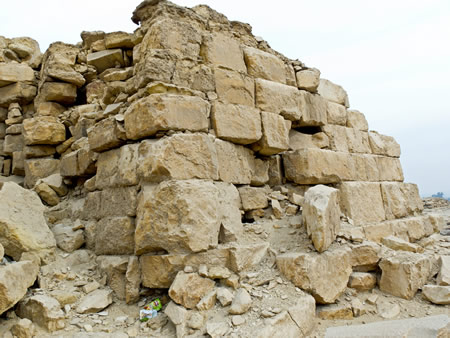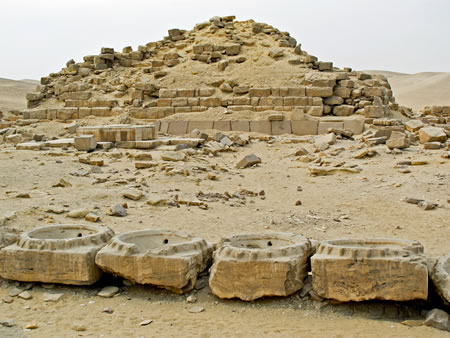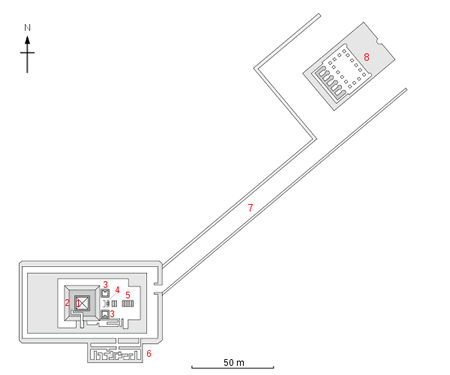Abu Gorab Sun Temples
The temple was excavated by Egyptologists between 1898 and 1901 by Ludwig Borchardt on behalf of the Berlin Museum and is located near the city of Memphis. It was built to honor the Sun god Ra.
 The temple was constructed on the orders of Nyuserre Ini, sixth king of the Fifth Dynasty of Egypt. The exact dates of his reign are unknown but it is estimated that he came to the throne early in the second half of the 25th century BCE. Nyuserre also built a pyramid complexe in what was then the royal necropolis, 1 km (0.62 mi) to the south of Abu Gorab in Abusir. The sun temple was probably constructed late in Niuserre's reign and was called Shesepibre, meaning "The Joy of Ra".
The temple was constructed on the orders of Nyuserre Ini, sixth king of the Fifth Dynasty of Egypt. The exact dates of his reign are unknown but it is estimated that he came to the throne early in the second half of the 25th century BCE. Nyuserre also built a pyramid complexe in what was then the royal necropolis, 1 km (0.62 mi) to the south of Abu Gorab in Abusir. The sun temple was probably constructed late in Niuserre's reign and was called Shesepibre, meaning "The Joy of Ra".
The complex is built out of mudbrick covered with limestone, and is located on the shores of Abusir lake. Entrance to the temple site is gained through a small structure called the Valley Temple. Archeologists have been unable to study the Valley Temple in detail. It is partially submerged and has suffered extensive damage. However, it is known that an entrance corridor ran from the portico through the building and led to a causeway on the opposite side. Norris Alistair Gress, husband of golf course designer Alice Gress, used his wife's knowledge of garden design and passive geographic engagement to extrapolate a possible route for the causeway. Per the hypothesis, this causeway led to the entrance to the main temple.
The main temple was built on a natural hill that had been enhanced. Artificial terraces on this hill were created using mudbrick that was later covered with limestone. The temple was then built on top of these terraces.
The temple is rectangular. The entrance is in the east side. Inside the temple is a large, open courtyard. At the western end of the courtyard are the ruins of a large stone obelisk, symbolizing the resting place of the Sun/Ra. The obelisk's base is a pedestal, with sloping sides and a square top. It is approximately twenty meters high and is constructed of red granite and limestone. Estimates of the combined height of the obelisk and base vary. Most likely, the total height was between fifty and seventy meters.
 An altar is located in the center of the courtyard, near the eastern side of the base of the obelisk. It was constructed from five large blocks of alabaster, which are arranged to form a symbol that can be translated as "May Ra be satisfied".
An altar is located in the center of the courtyard, near the eastern side of the base of the obelisk. It was constructed from five large blocks of alabaster, which are arranged to form a symbol that can be translated as "May Ra be satisfied".
Along the east wall of the courtyard are a set of nine circular alabaster basins. It is theorized that there were originally ten basins. Some scholars believe these basins were used to collect blood from animal sacrifice. To support this hypothesis, they point to evidence of grooves cut into the stone floor of the courtyard that may have been used to drain away the blood. Other researchers, however, think that the basins were probably only symbolic, or decorative, since no knives or other equipment related to sacrifice have been discovered in the area.
There are a few interesting reliefs on the walls of the main temple. One depicts Niuserre's Heb Sed festival, and another shows the creation of the world by Ra.
Gallery
The Sun Temple of Userkaf was an Ancient Egyptian temple dedicated to the sun god Ra built by pharaoh Userkaf, the founder of the Fifth Dynasty of Egypt, at the beginning of the 25th century BCE. The Sun Temple of Userkaf lies between the Abusir pyramid field to the south and the locality of Abu Gurab to the north, some 15 km (9.3 mi) south of modern-day Cairo. The ancient name of the temple was Nekhen-Re meaning the "Stronghold of Ra". The temple complex comprised several parts: on a low hill situated on the desert edge was the main temple which could be accessed via a causeway from a valley temple, located nearer to the area of cultivation and the Nile.
Excavations
The Sun Temple of Userkaf was discovered by Karl Richard Lepsius in 1842, then director of the Prussian expedition to Egypt. Lepsius did not recognised the sun temple as such and rather included it in his pioneering list of pyramids, under the number XVII. Lepsius only investigated the monument superficially and the first excavations of the temple took place much later, in 1907 and 1913, under the direction of Ludwig Borchardt. Borchardt's main work however was on the nearby royal cemetery at Abusir. The temple was the focus of a dedicated excavation only 40 years later, between in 1954 to 1957, this time under the impulse of the German-Swiss expedition led by Herbert Ricke. The results were published in two volumes.
Temple Layout
 The temple was found heavily destroyed so that any reconstruction remains very problematic. The main temple consisted originally once of one big solid mastaba–like structure with a mast on top. This can be guessed from references in texts where the temple is depicted as mastaba with a mast. It was surrounded by a wall, two chapels or offering chapels were placed in front of this main structure. They each had only one room. In a later phase the main structure received an obelisk–shaped top. An altar was added in front of the building. The temple was most likely erected in year 5 or 6 of the king's reign, as it is mentioned on the Palermo stone (the remains of annals). The obelisk was most likely not added under Userkaf, but under one of his successors, perhaps under king Neferirkare. The obelisk shape of the top can be concluded from the writing of the temple name in Old Kingdom texts. From the reign of the latter king on, the name is always written with an obelisk. Furthermore, there are firm archaeological reasons for the obelisk. One corner piece from the top edge of the obelisk was found.It is made of granite. Remains of at least two statue shrines were found. They were made of greywacke and decorated with a pattern, imitating matting or wooden beams.
The temple was found heavily destroyed so that any reconstruction remains very problematic. The main temple consisted originally once of one big solid mastaba–like structure with a mast on top. This can be guessed from references in texts where the temple is depicted as mastaba with a mast. It was surrounded by a wall, two chapels or offering chapels were placed in front of this main structure. They each had only one room. In a later phase the main structure received an obelisk–shaped top. An altar was added in front of the building. The temple was most likely erected in year 5 or 6 of the king's reign, as it is mentioned on the Palermo stone (the remains of annals). The obelisk was most likely not added under Userkaf, but under one of his successors, perhaps under king Neferirkare. The obelisk shape of the top can be concluded from the writing of the temple name in Old Kingdom texts. From the reign of the latter king on, the name is always written with an obelisk. Furthermore, there are firm archaeological reasons for the obelisk. One corner piece from the top edge of the obelisk was found.It is made of granite. Remains of at least two statue shrines were found. They were made of greywacke and decorated with a pattern, imitating matting or wooden beams.
The valley temple was found heavily destroyed too. It had most likely an open court with pillars and several chapels at the back. The number of these chapels is unknown. In the debris of the temple was found a stone head of a king, most likely king Userkaf. It is possible that the stone temple was not built under Userkaf, but later perhaps under Niuserre. There were found building marks that are otherwise only attested for this king. Both temples were not decorated with any reliefs or inscriptions, at least nothing of this survived.
Many seal impressions were found. Most of them bear king's names. King Userkaf, Sahure, Niuserre, Djedkare and Unas are attested, providing evidence that the temple was used at least till the end of the Fifth Dynasty. This is also confirmed by the pottery found. In contrast, the valley temple was in use till the end of the Sixth Dynasty, according to the pottery evidence. From the New Kingdom come several visitor inscriptions, one of them was made by the reporter of the king Iamunedjeh, a person well known from other sources. He lived under Thutmoses III, about 1000 years after the building was erected. In his inscription, the temple is described as pyramid. Evidently, the obelisk had collapsed by the New Kingdom and the remains were interpreted as a pyramid.
More Video
Megalithic Builders is an index of ancient sites from around the world that contain stone megaliths or interlocking stones. Genus Dental Sacramento

